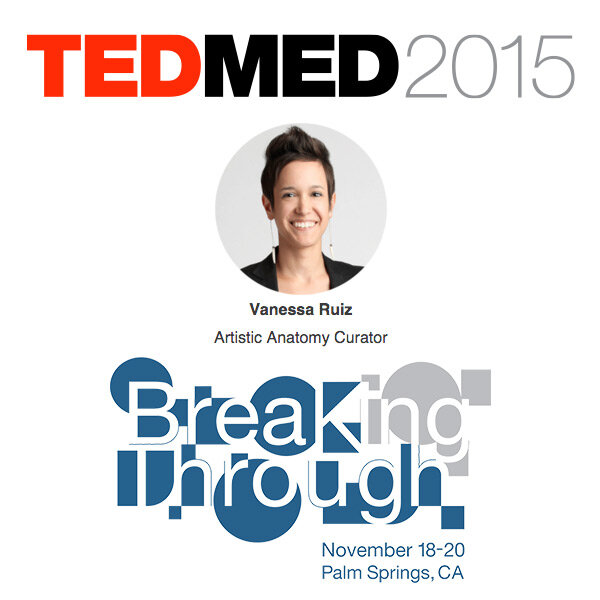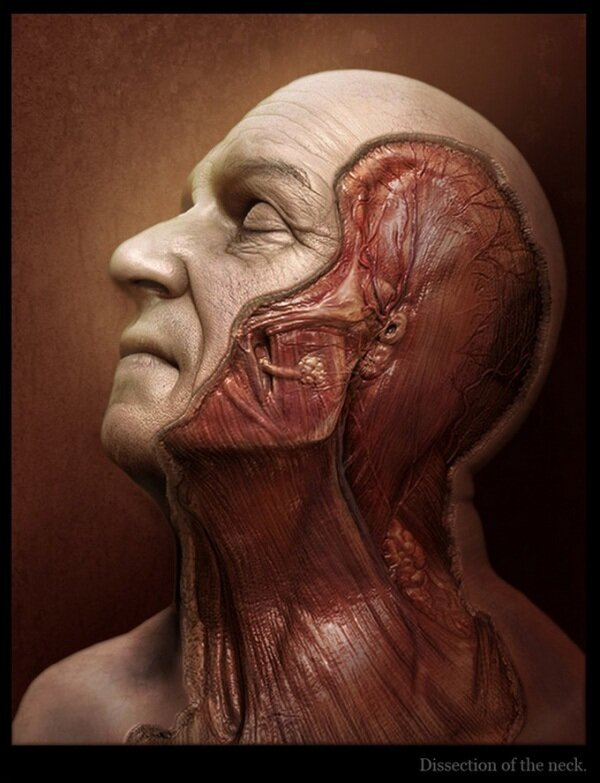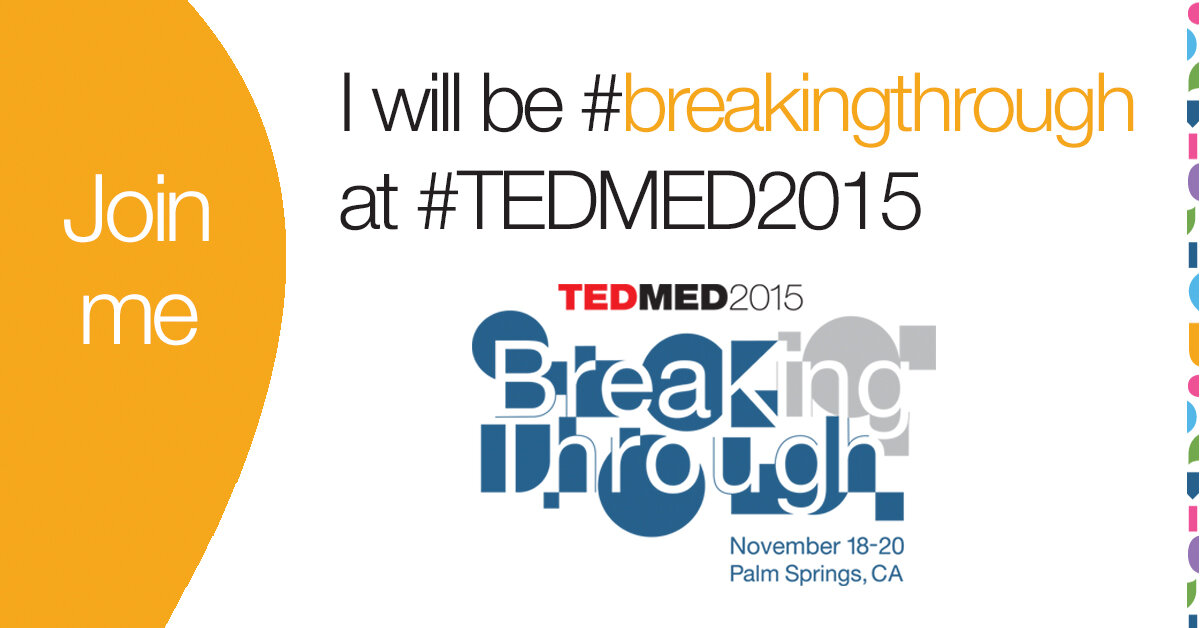Street Anatomy at TEDMED 2015!

Join me at TEDMED 2015 this November when I share how I'm taking anatomy to the streets, and making medical illustration, and the resulting public knowledge of the human body, intersect with contemporary art.
For those of you not attending TEDMED (because it costs big chunk of change), I'll let you know as soon as the talk is released on TEDMED.com!
The Journey So Far
A few months ago I received an invitation to be a speaker at TEDMED 2015. Being such a huge honor, I immediately said, "Yes! Of course!" Now, I knew it would be hard, but I didn't realize it would be this hard.
Within three weeks of accepting the invitation, TEDMED asked me to submit the first draft of my talk. The talk isn't for another 4 months and I have to figure out what I'm saying in three weeks? That's how much TED/TEDMED wants you to prepare for what is now considered to be the standard of presentations—highly produced, informational, inspirational, and short. I have to fit my entire purpose and vision behind Street Anatomy into 12 short minutes. But what exactly is my purpose and vision?
In these past few months I have read up on giving great presentations and watched endless TED talks. I've researched the entire history of anatomical illustration and analyzed the works of every contemporary anatomical artist I've featured on Street Anatomy. I've been high with confidence and reduced to tears from self-doubt. TEDMED has been the most challenging thing I've faced in a long time.
This whole process kicked me hard to figure out why I have run Street Anatomy so passionately for the past 9 years and counting.
The Back Story
I started Street Anatomy late in 2006, during my first semester at UIC's Biomedical Visualization graduate program ("Biomedical Visualization" is a fancy term for medical illustration). At that time, I was so excited to become a medical illustrator. But also so disappointed that no one I talked to knew what that meant. (If you're thinking to yourself, "I actually don't know what a medical illustrator is either..." then head over to the Association of Medical Illustrators website. It provides a ton of information on this field that so beautifully balances art and science.)
Back then blogging and social sites were taking off in popularity, as was street art. I would spend my weekends biking around Chicago taking photos of the street art, graffiti, and stickers in Pilsen and Wicker Park. Then I would post the photos on Flickr's Chicago Street Art group. I became obsessed with seeing how many views my photos accumulated and with reading the comments people left. The street art community thrived on Flickr. Artists shared their work and looked out for each other. I dreamt about being a street artist. I'd look at the side of a building and envision a giant figure showing the back muscles or see an anatomical heart on the back of a stop sign. But I never really had the guts to be a street artist. Plus, I was in grad school focusing on becoming a serious medical illustrator...or so I thought.
Curious to whether any medical illustrators were sharing their work like the street art community, I searched Google for "medical illustration blogs." Nothing came up. There were, of course, portfolios out there, but no one talking about their process or even about the medical illustration field! And if they were out there, they weren't easy to find. This shocked and disappointed me. But more importantly, it moved me to think, "well if no one else is doing it, then I'll do it myself."
Timing is everything with ideas. The lack of public knowledge about medical illustration and the rise of the self-publishing internet set the foundation to build a blog about medical illustration. Thinking of what to name it, I turned to my interest in street art. My goal was to bring medical illustration— specifically anatomical illustration—to the public. To bring anatomy to the streets, in a not-so-illegal way. So, the name "Street Anatomy" popped into my head.
Armed with a name and a blogging platform (Google's Blogger at the time), I started to teach the world about medical illustration. I wrote posts about the different types of medical illustration, about medical imaging technology, and even historical anatomical illustration. It took a lot of freaking time. But, I knew that in order to make Street Anatomy successful and grow an audience, I had to work on it everyday. This determination came at the expense of my grad school grades. Class projects would lay unfinished as I focused more and more attention on Street Anatomy. My professors, while frustrated with me at times, were also surprisingly supportive. Maybe they saw the potential.
From Medical Illustration to Contemporary Anatomical Art
Many times I found myself without the time to write long posts on medical illustration. So in a panic to post something, I began to search for images of anatomy outside of the medical realm. I wanted to see what artists, free from the constraints of accuracy, were doing with anatomy. The first image I stumbled across was a hyper realistic 3D rendering of head and neck anatomy by 3D artist, Tsvetomir Georgiev. He created it directly from a historical anatomical illustration. It was the first time I saw this type of blending of historical illustration with new technology.

I wrote on that post 9 years ago,
"I feel that the future of medical illustration lies in such dynamic images. Medical illustrators often need to look outside of their field for inspiration. Tsveotmir’s work is a good example. He is not a medical illustrator and yet he is simply copying these classic medical images and transforming them into something more visually dynamic. He has improved upon the past and created a medical visual more relevant to today’s world."
People responded to and shared that post more than any of my other long posts about medical illustration. From that moment on I began to insert more anatomical art into Street Anatomy, from Damien Hirst to anatomical cartoons. But it wasn't easy to find. I had to do a lot of searching to find contemporary anatomical art. At the same time I was taking medical illustration classes that were teaching me to take the artistry out of illustration, I was seeing how artists were pushing the boundaries of anatomical representation. It was almost a conflict of interest. My interest in illustrating waned as my interest in art and design grew.
After grad school, I became an art director for a pharmaceutical advertising company. I got to hire and work with other medical illustrators and use the art I featured on Street Anatomy for inspiration. Eventually I found myself doing visual and user interface design, far removed from illustration, but an increasing passion of mine. I still use my skills as a medical illustrator everyday. The balance of art and science drives me to research and simplify complex problems. It's scientific analysis with creative execution that makes medical illustrators so valuable in any field, not just illustration.
Street Anatomy Today
Street Anatomy is where artists can find inspiration, and those with an interest in anatomy and medicine can see the many ways in which it is visually expressed.
This little blog, whose purpose it was to educate the public about medical illustration, grew into a platform to showcase contemporary anatomical art. From it, I've curated several gallery shows in Chicago, started an online store, and have been invited to do talks on the subject (yay TEDMED!). Some deep purpose keeps me working on Street Anatomy everyday. It pushes me to search for anatomical art, write posts, build relationships with artists, ship anatomical art (and even wallpaper) all over the world, and much more.
9 years ago it was difficult for me to find contemporary anatomical art, now it's everywhere. People are tattooing anatomy on their bodies, wearing it on their clothes, and putting it up as art in their homes. The public has become so much more open to anatomical art now than ever before.
There's an enormous amount of information, research, and analysis of the history of anatomical illustration out there. I feel compelled to showcase and catalog the contemporary anatomical art. As well as promote the artists and medical illustrators that are pushing the boundaries of anatomical visualization. Because one day, they will be part of the history that leads to something greater—to fully appreciate and understand our anatomy.
What does this all mean? What is the potential here? This is what I hope to answer through my TEDMED talk. If nothing else, to expose people to the appreciation of anatomy through art!

